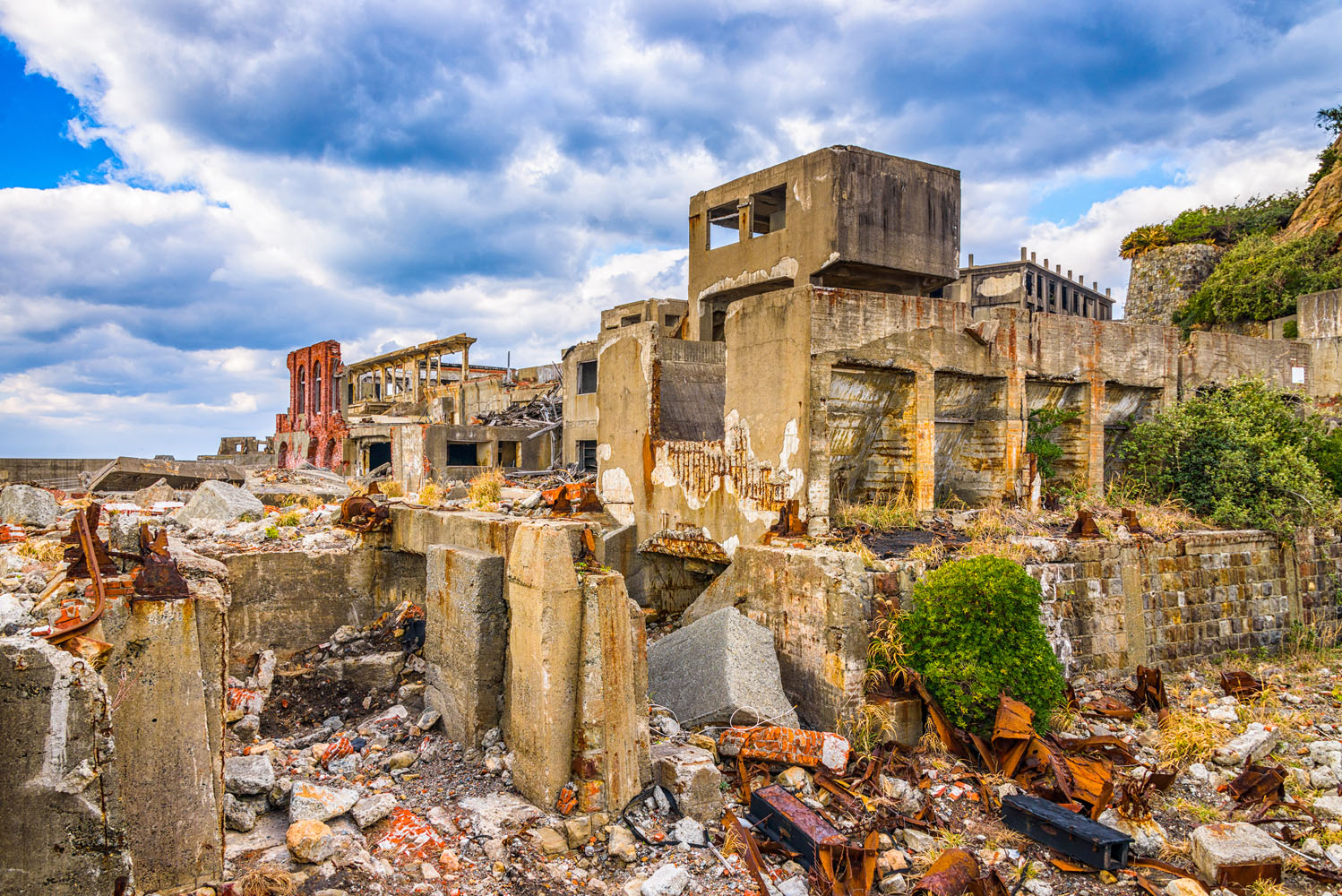

FAMOUS ABANDONED PLACES IN JAPAN
Urbex – dark tourism
Urbex stands from ‘urban exploration.’ The adventure involves visiting inaccessible, uninhibited or hidden sites. The most thrilling experience for those who enjoy this pastime is visiting abandoned places. The Japanese have also found their own equivalent for the sightseeing of ruins – it is haikyo (廃墟), while fans of urban explorations are called haikyoists. Why are there plenty of abandoned places in Japan?
One day there is a school and a moment later it’s gone. People spend their free time in an amusement park and the next week it is closed down. This is all because of the galloping industrialisation, mass migrations to cities and the economic and demographic problems of the country. Japan has low birth rate and the ageing society is one of its major issues. Because of all this, some factories, facilities and establishments no longer bring profit and need to be closed down.
Abandoned Hashima island
It was just in the middle of last century that Hashima (端島), also called Gunkan-jima, (軍艦島), that is ‘warship island,’ was a major industrial centre. It was famous for coal extraction, with deposits situated 600 metres below sea level. Its peak population was over 5,000. People had to live within an area of 6 ha, which is just twice the area of the Manufaktura Shopping Mall in Łódź, Poland. When coal lost its value in favour of crude oil, the town became a ghost island overnight.
There were two attempts to add it to the UNESCO World Heritage List. The first one (2008) was opposed by South Korea, who addressed the inhumane treatment the local Korean workers suffered from Mitsubishi. Koreans spent years fighting for compensation for the anguish of the miners, to no avail. Another attempt, in 2015, was successful and the Hashima island has been on the UNESCO list ever since.
A fun fact: Hashima, just like many other Japanese sites, had its role in a Hollywood film. Its image was used for the James Bond instalment Skyfall.
Nichitsu – a ghost town in Japan
Nichitsu (日窒) is one of the most popular urbex sites. The town was founded because of the nearby mine, whose workers started to settle down in the vicinity. When the interest in coal was high, the population was about 3,000. However, the raw material lost is significance at some point and the town went into decline.
The houses left after the former inhabitants of Nichitsu were inherited by the younger generation. But no one had any intention of returning to the abandoned town, and especially of taking care of the decaying inheritance. People who had city life prospects and hoped for a better tomorrow left their possessions and never came back to Nichitsu. The state had to incur the costs of either securing or demolishing the old buildings.
Abandoned Nara Dreamland
The amusement park built in 1961, inspired by the California Disneyland, used to be a source of laughter and joy. Until 2006, tourists could enjoy the speed of steep roller-coasters, spin on marry-go-rounds, admire the replica of “Main Street, U.S.A,” or treat themselves to cotton candy and waffles. However, the once thriving amusement park turned into a haunted place. Today, the desolate view of Nara Dreamland (奈良ドリームランド) invokes fear and terror.
As time went by, the free time preferences changed. Japan has so many tourist attractions that the foreigners visiting the Country of Cherry Blossoms could not even learn about the existence of Nara Dreamland. Natives, on the other hand, are satisfied with arcade games, smartphones and computers. Besides, much newer and more prestigious amusement parks emerged in the meantime, such as Disneyland in Tokyo (1983). The turn of events left the Nara park without hardly any customers.
Forgotten Doctor Sataro Fukiage Hospital
On Hokkaido, haikyoists may discover the abandoned Doctor Sataro Fukiage Hospital. Things get even eerier if we realise that a Japanese serial killer of the beginning of the 20th century had the same name. Unlike the previously discussed desolate facilities, the clinic is surrounded by other buildings. Still, it is hard to pass by indifferently as the place attracts the eye with its squalid appearance. On the outside, next to the entrance, there is still a notice with opening hours and phone numbers.
The interior gives an impression as if time has stopped. The window of the reception desk is still open and the vending machine in the waiting room is still full. Calendars from 1995 are hanging on the wall. All rooms are fully equipped, with drawers and shelves filled with needles, surgical tools, x-rays, piles of old papers and various medications. Standing in the middle of the operating theatre are lamps, the bed and old equipment. As you enter the Doctor Sataro Fukiage Hospital, you will feel the atmosphere of old times in a slightly spooky version.
There are plenty of fans of dark tourism, and visiting abandoned bloodcurdling sites is an incredible experience. The list of such places seems to be endless and keeps growing. However, entering abandoned areas is usually prohibited. An intruder caught red-handed may suffer severe consequences. The fine may be even a thousand euros. Some believe, though, that the experience is worth it.























